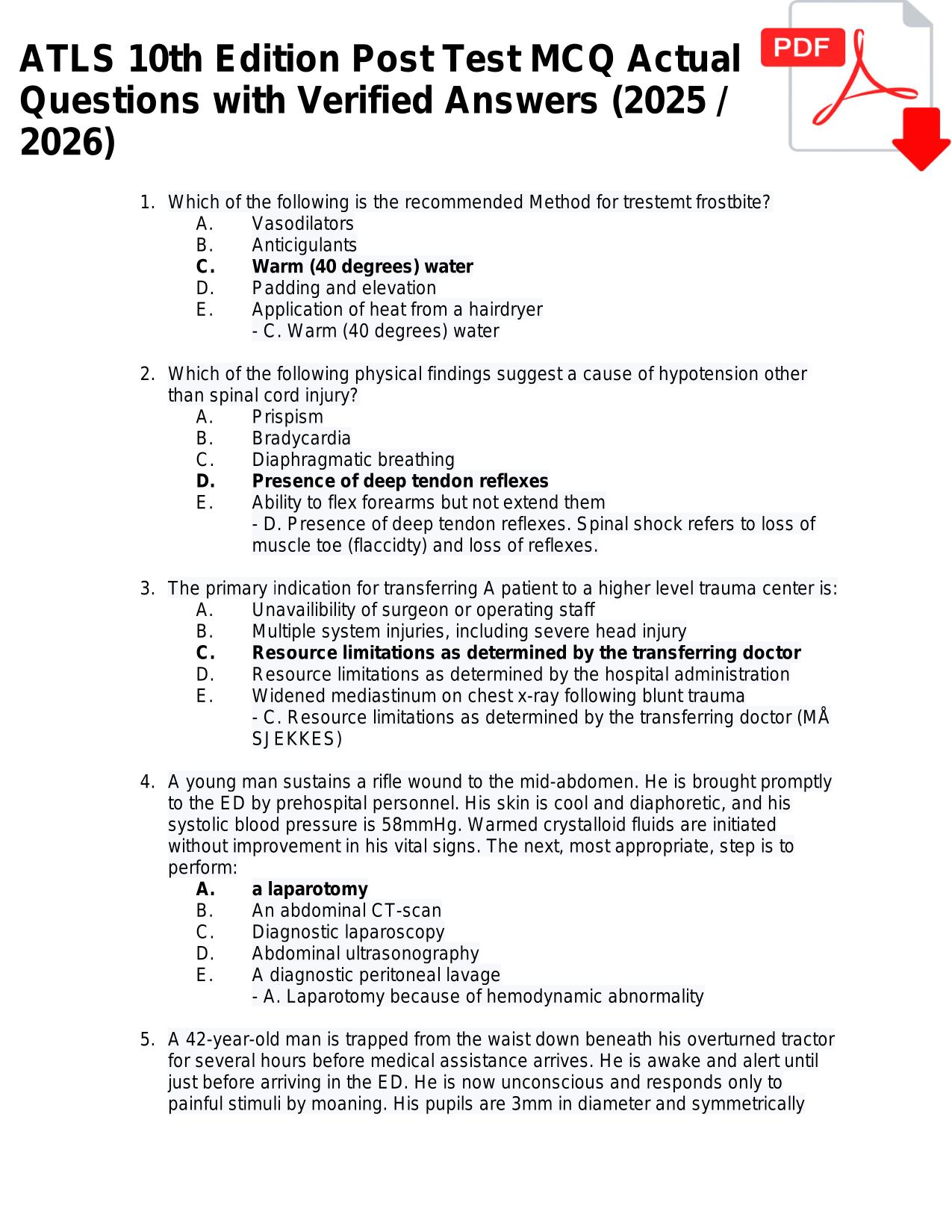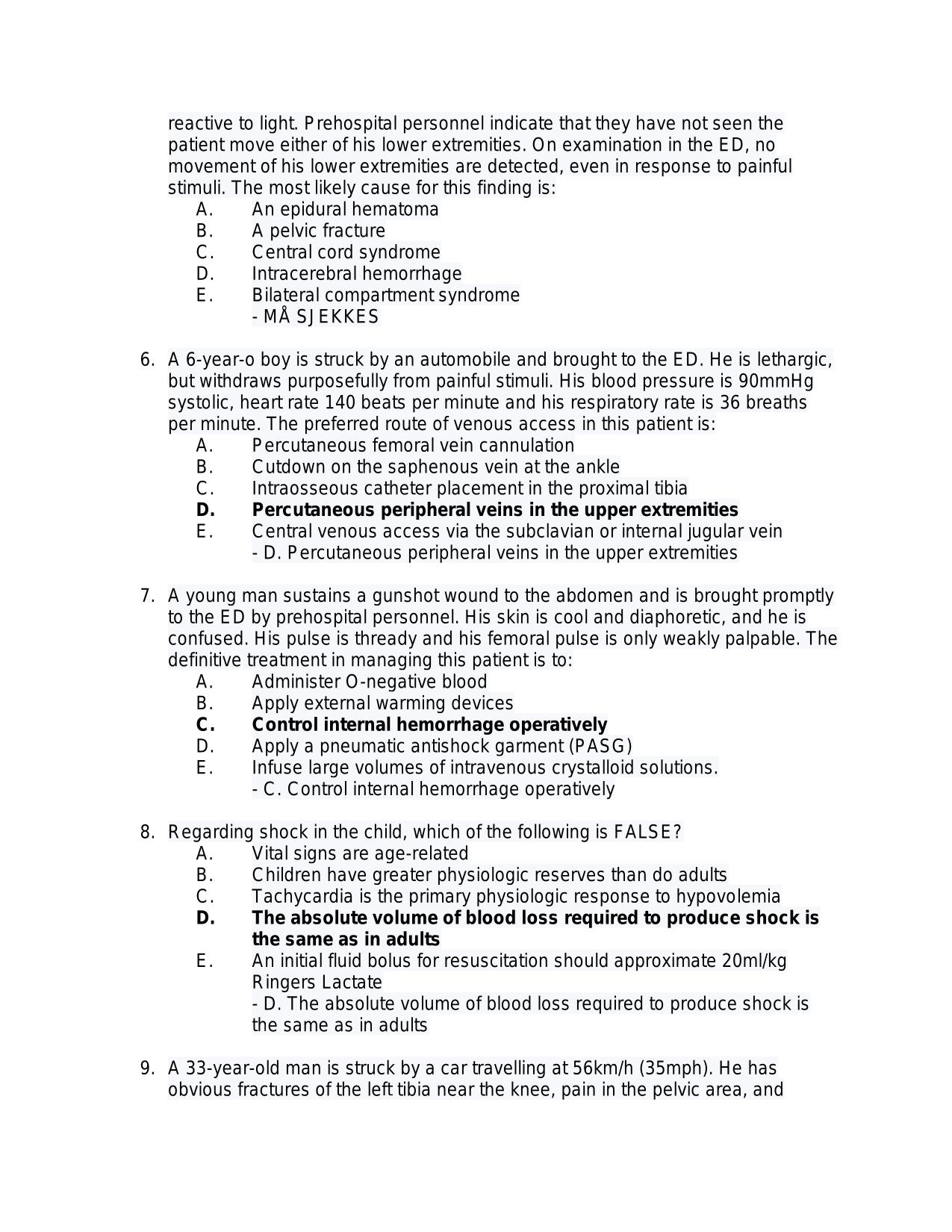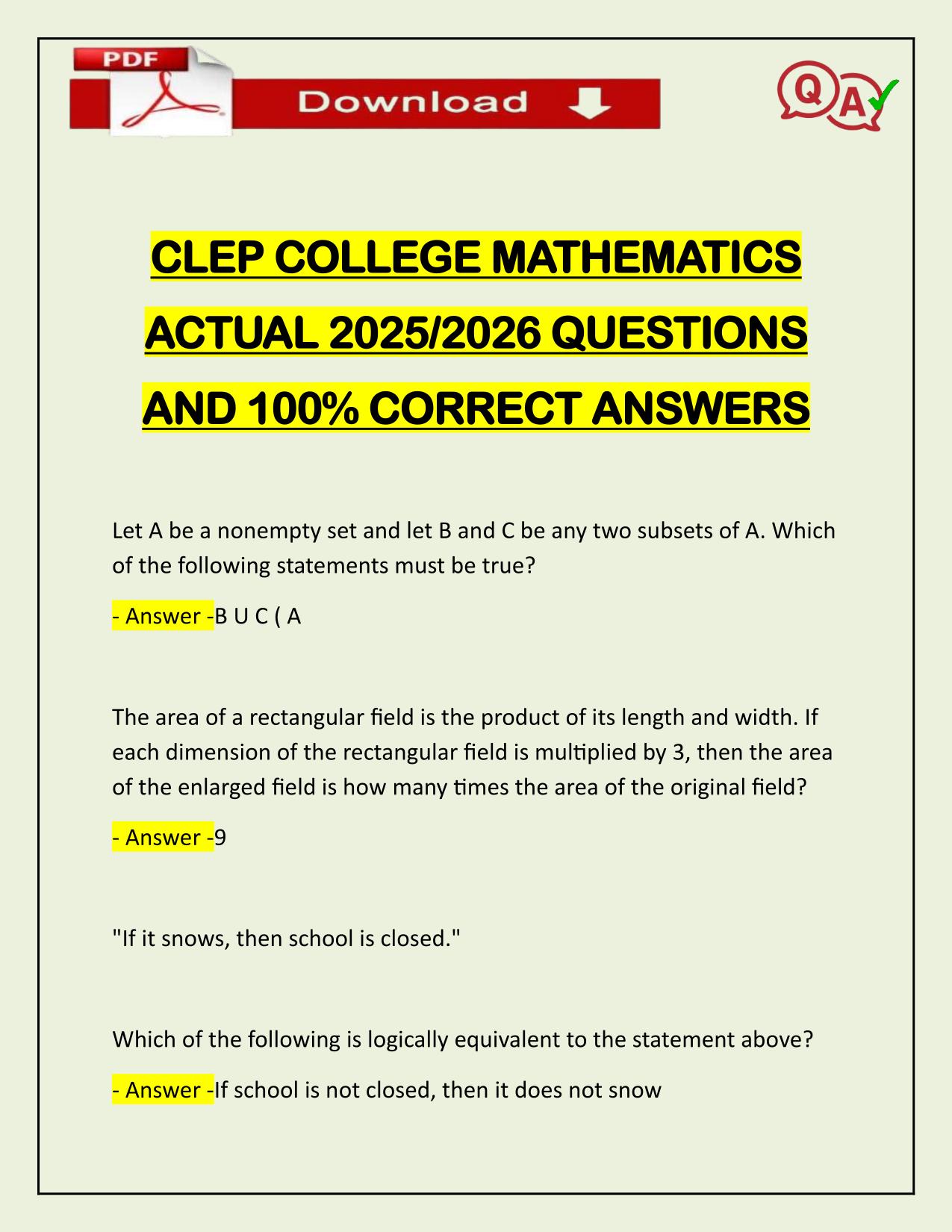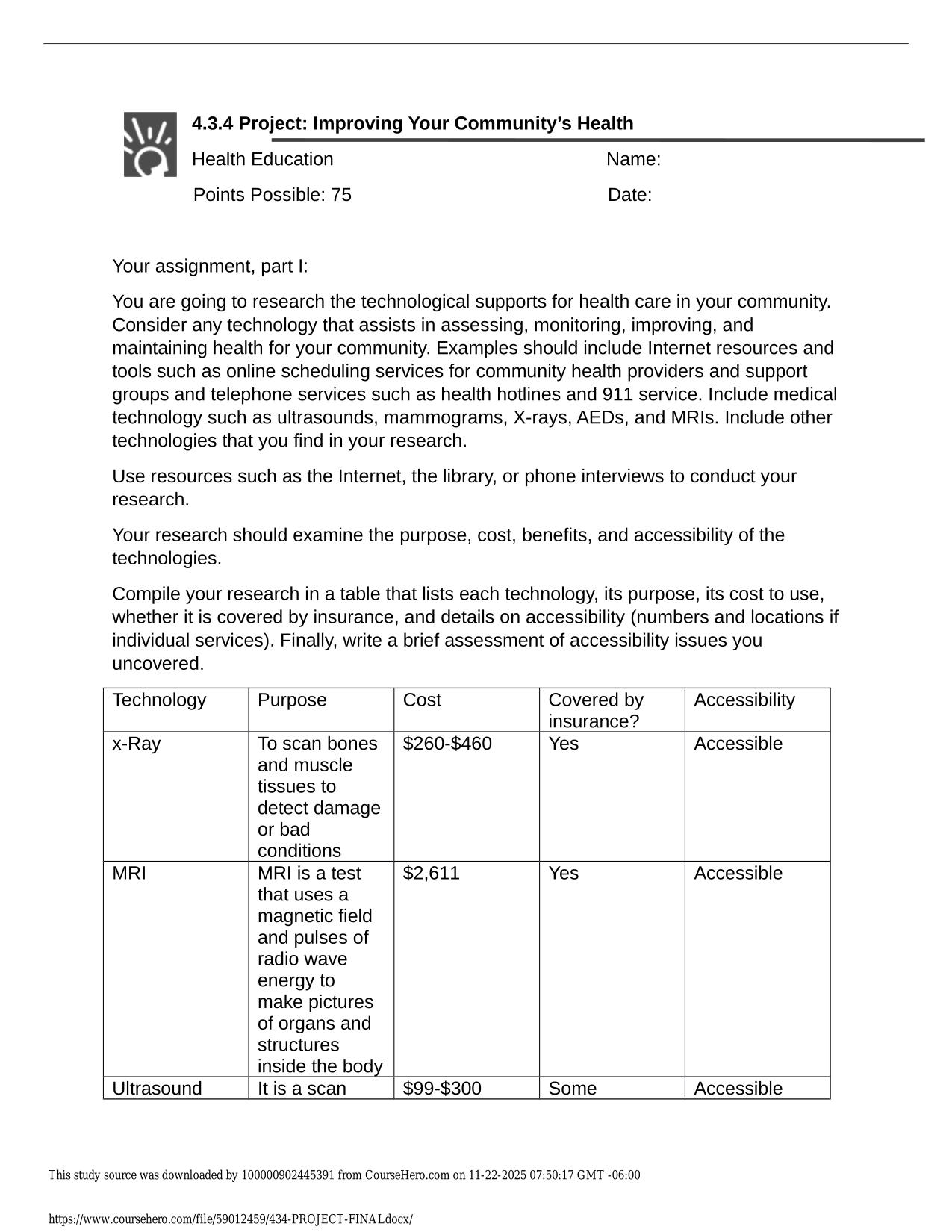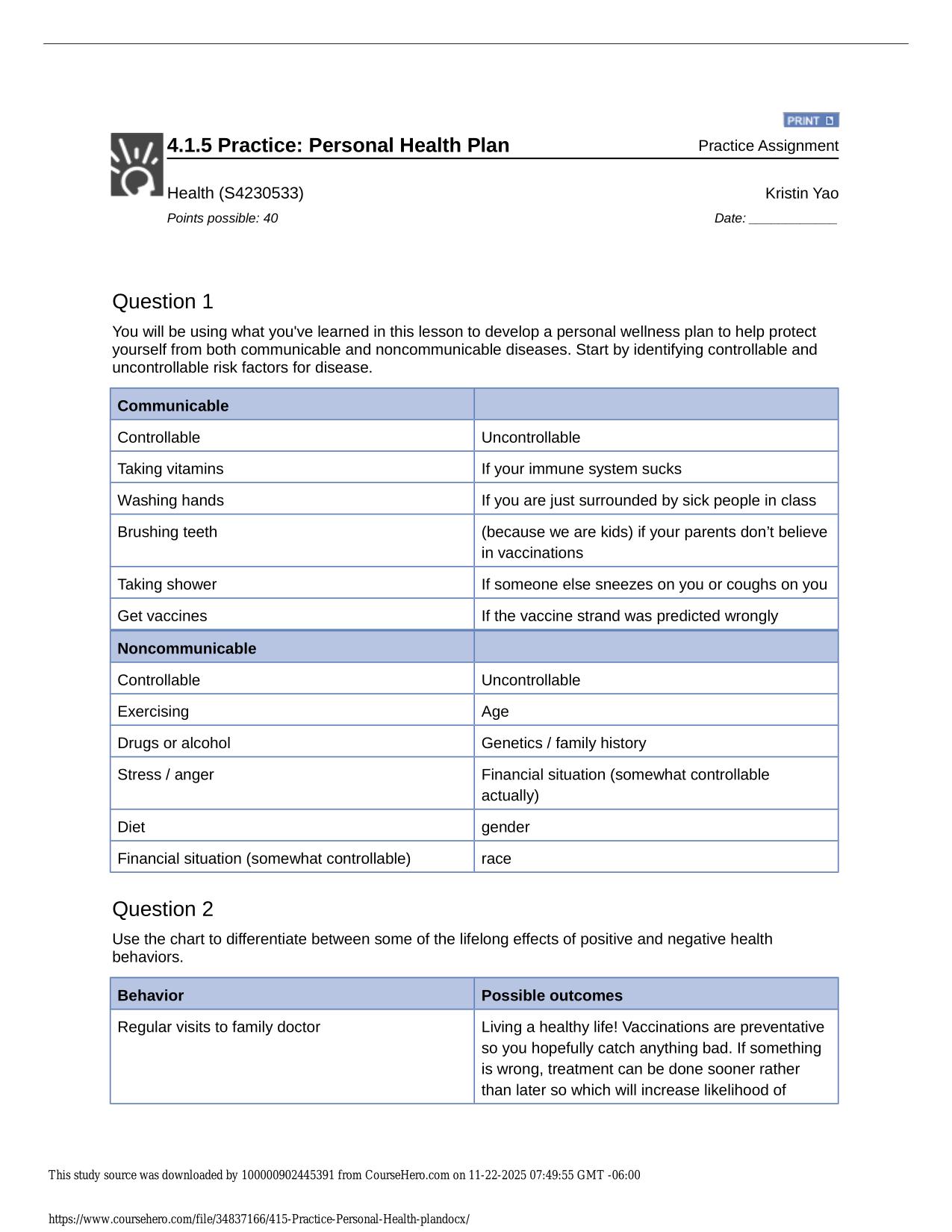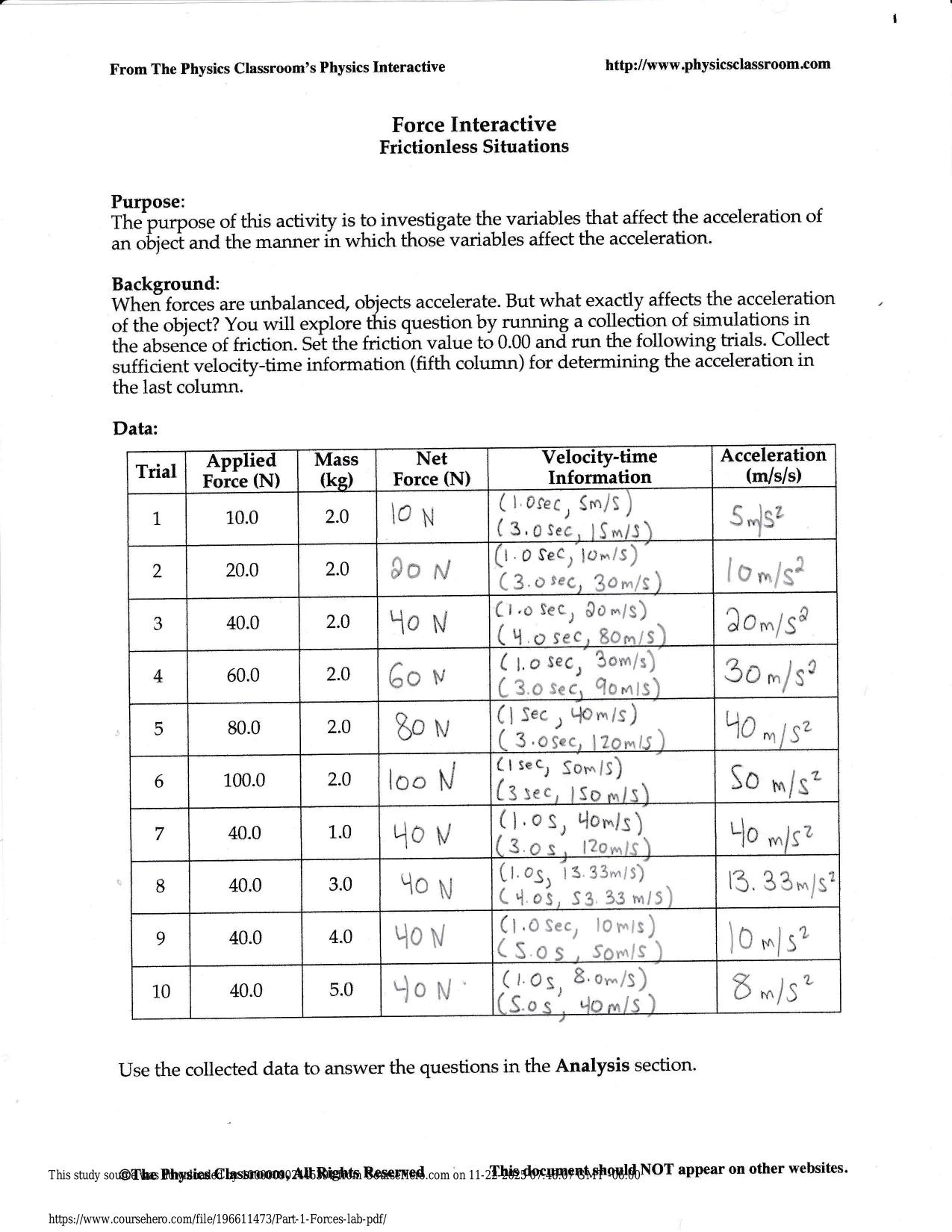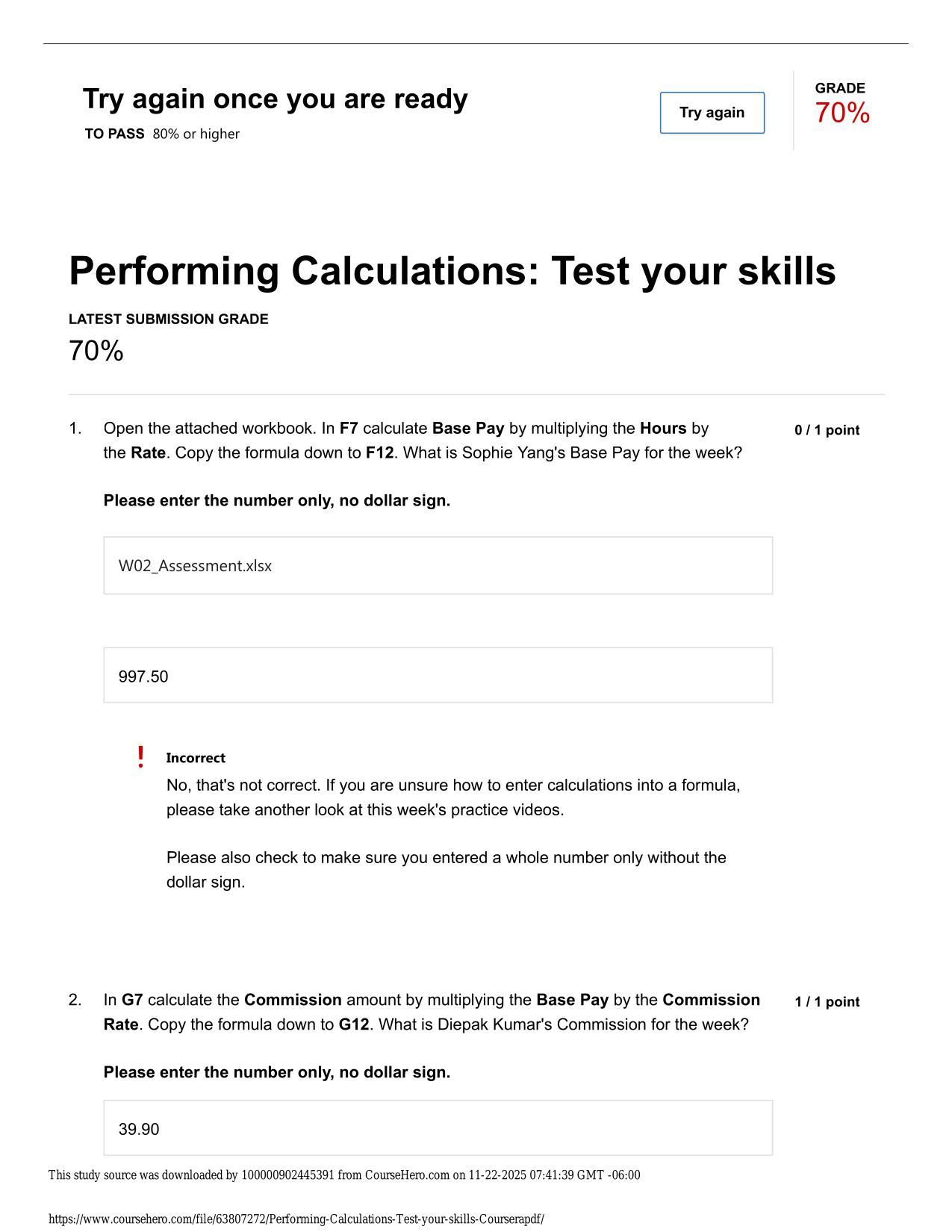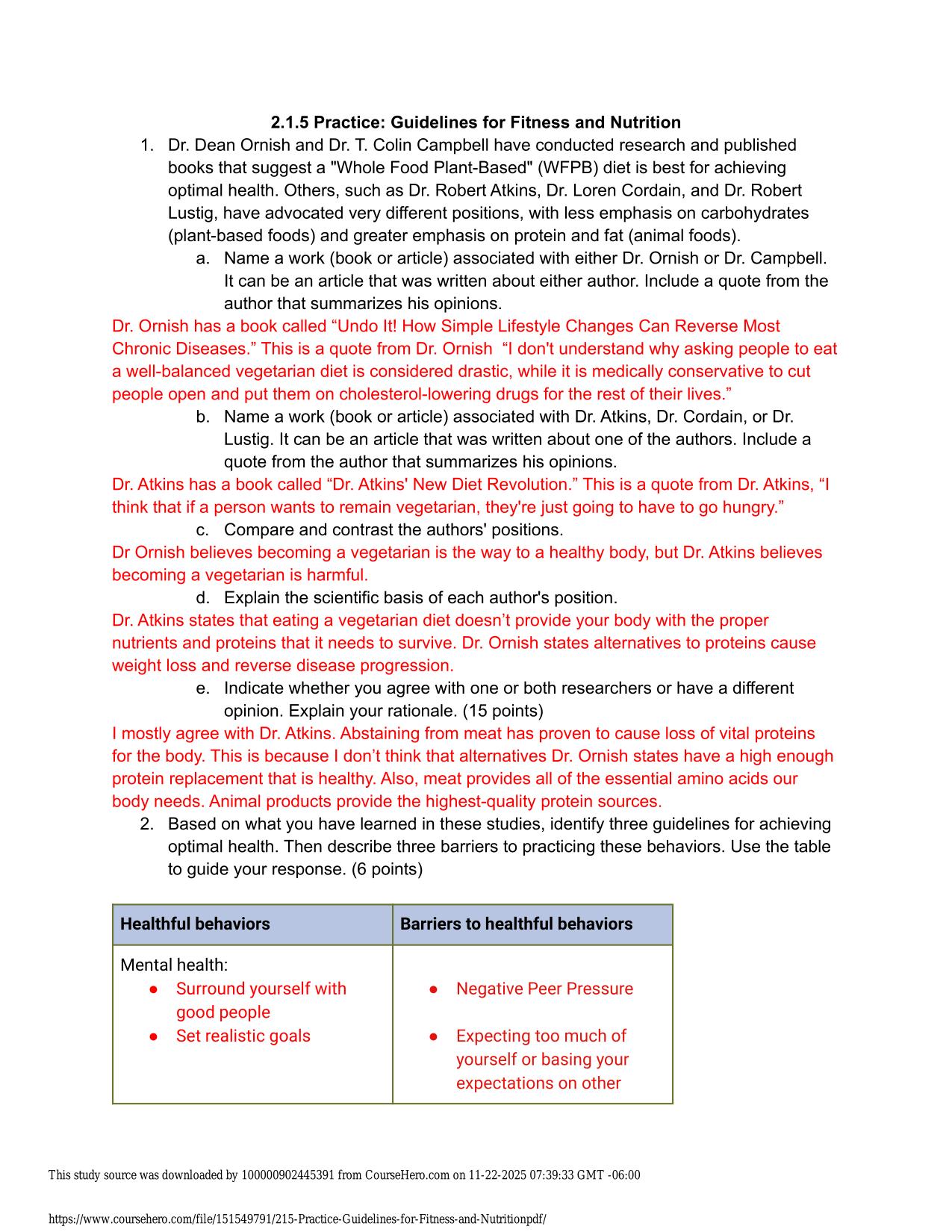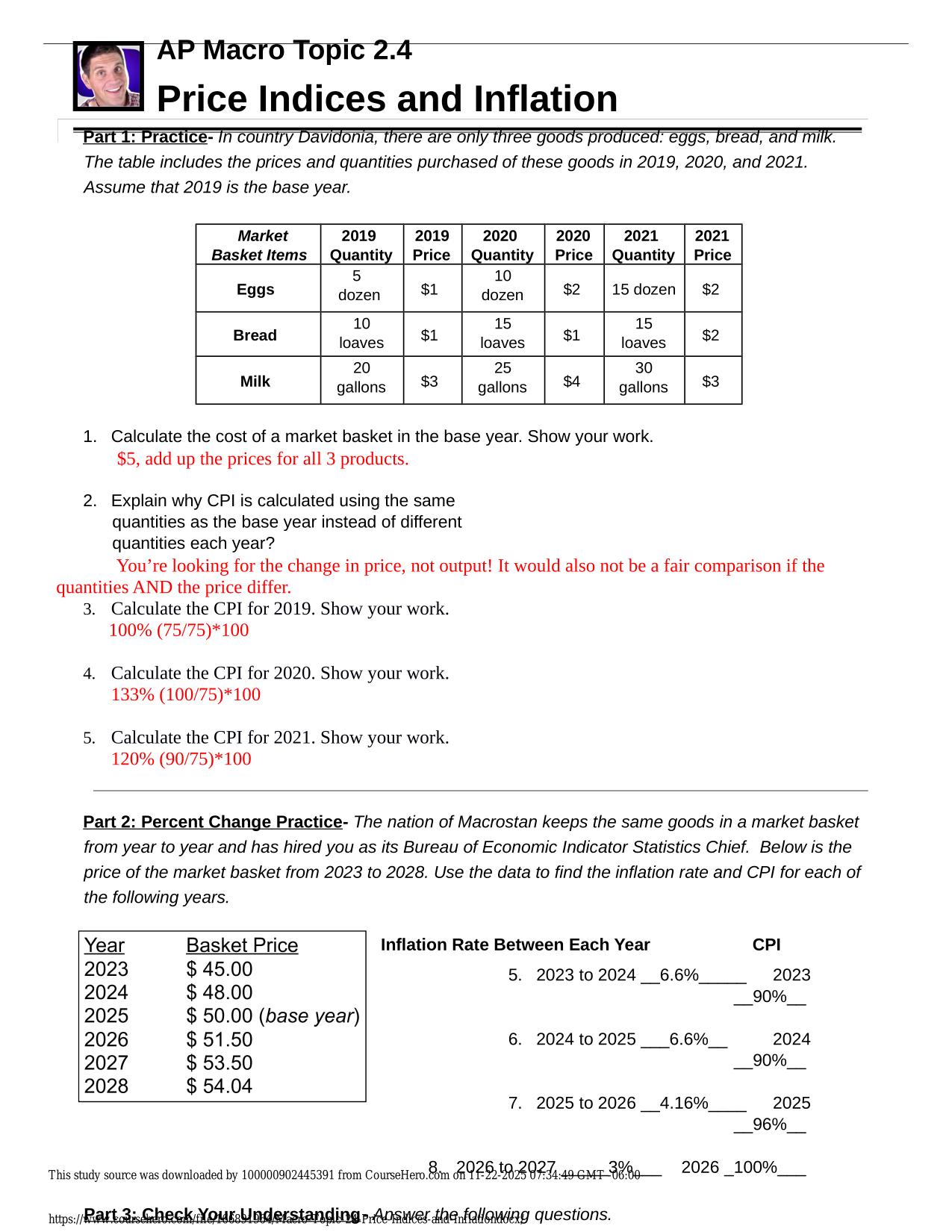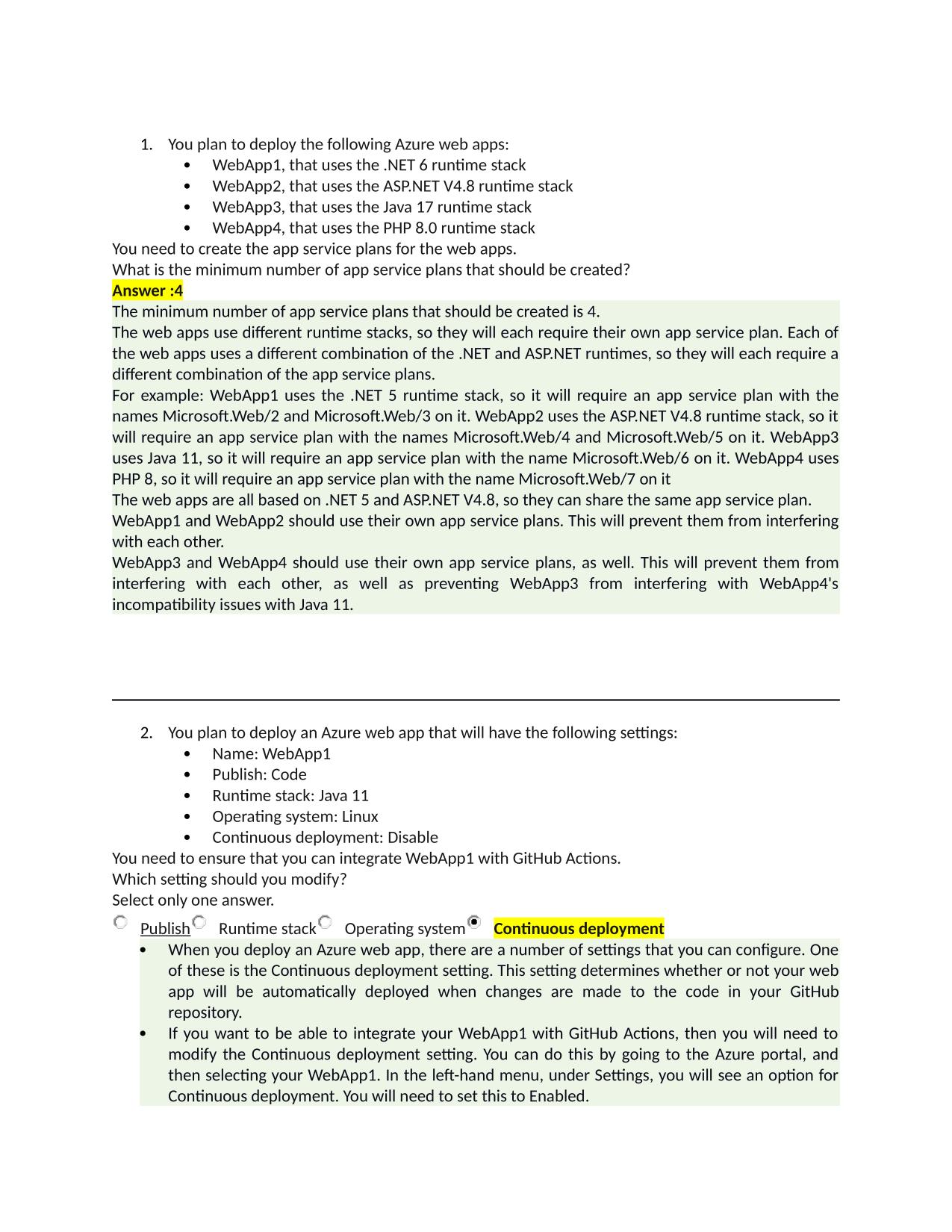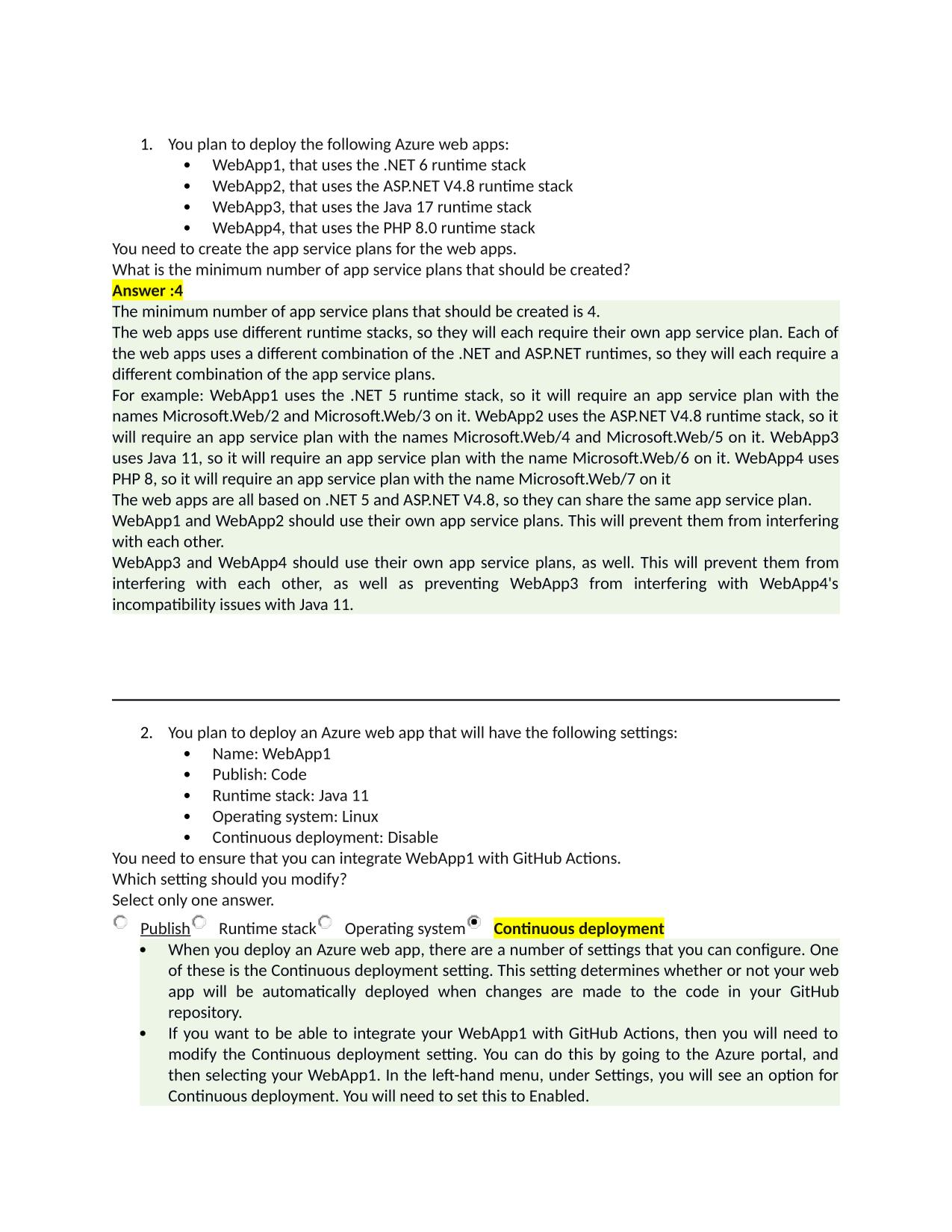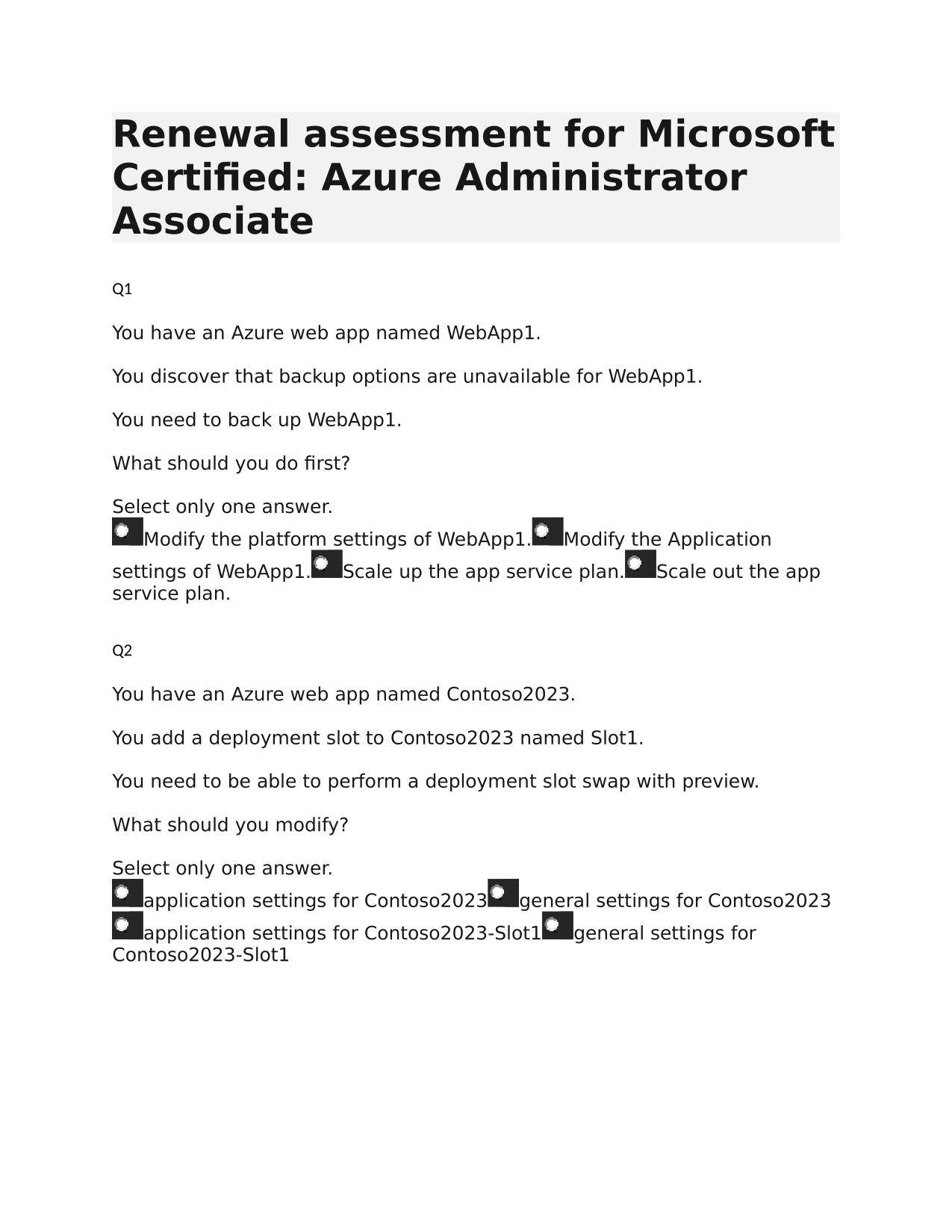ATLS 10th Edition Post Test MCQ Actual 2025/2026 Questions with Verified Answers
Course:
ATLS
Institution:
ATLS
ATLS 10th Edition Post Test MCQ Actual 2025/2026 Questions with Verified Answers 1. Which of the following is the recommended Method for trestemt frostbite? A. Vasodilators B. Anticigulants C. Warm (40 degrees) water D. Padding and elevation E. Appli...
After purchase, you get:
✅ Instant PDF Download
✅ Verified answer explanations
✅ Refund if not Satisfied
✅ Prepared for 2025/2026 test cycle
Overview
thorough reasoning encourage slow, intentional study, ideal for improving accuracy on difficult exam items. The material rewards careful, thoughtful engagement rather than rushed skimming. This deliberate approach helps build the patience and attention to detail needed for high-stakes testing. Students often notice their accuracy improves significantly when they adopt this more mindful study method.
Who Is This For?
This resource supports test-takers in ATLS, healthcare trainees, and certification candidates seeking top-tier practice. Many users appreciate how it mirrors actual exam conditions. The material has helped numerous students build assurance before their important tests.
Related Keywords
Detailed Study Description
Frequently Asked Questions
Document Information
| Uploaded on: | November 1, 2025 |
| Last updated: | December 8, 2025 |
| Number of pages: | 42 |
| Written in: | 2025/2026 |
| Type: | Exam (elaborations) |
| Contains: | Questions & Answers |
| Tags: | ATLS 10th Edition Post Test MCQ Actual 2025/2026 Questions with Verified Answers 1. Which of the following is the recommended Method for trestemt frostbite? A. Vasodilators B. Anticigulants C. Warm (40 degrees) water D. Padding and elevation E. Application of heat from a hairdryer - C. Warm (40 degrees) water 2. Which of the following physical findings suggest a cause of hypotension other than spinal cord injury? A. Prispism B. Bradycardia C. Diaphragmatic breathing D. Presence of deep tendon reflexes E. Ability to flex forearms but not extend them - D. Presence of deep tendon reflexes. Spinal shock refers to loss of muscle toe (flaccidty) and loss of reflexes. 3. The primary indication for transferring A patient to a higher level trauma center is: A. Unavailibility of surgeon or operating staff B. Multiple system injuries, including severe head injury C. Resource limitations as determined by the transferring doctor D. Resource limitations as determined by the hospital administration E. Widened mediastinum on chest x-ray following blunt trauma - C. Resource limitations as determined by the transferring doctor (MÅ SJEKKES) 4. A young man sustains a rifle wound to the mid-abdomen. He is brought promptly to the ED by prehospital personnel. His skin is cool and diaphoretic, and his systolic blood pressure is 58mmHg. Warmed crystalloid fluids are initiated without improvement in his vital signs. The next, most appropriate, step is to perform: A. a laparotomy B. An abdominal CT-scan C. Diagnostic laparoscopy D. Abdominal ultrasonography E. A diagnostic peritoneal lavage - A. Laparotomy because of hemodynamic abnormalit |
Seller Information

AdelineJean
User Reviews (0)
Exam (Elaborations)
$11.00
Add to Cart
100% satisfaction guarantee
Refund Upon dissatisfaction
Immediately available after purchase
Available in Both online and PDF
$11.00
| 0 sold
Discover More resources
Inside The Document
ATLS 10th Edition Post Test MCQ Actual Questions with Verified Answers (2025 / 2026) 1. Which of the following is the recommended Method for trestemt frostbite? A. Vasodilators B. Anticigulants C. Warm (40 degrees) water D. Padding and elevation E. Application of heat from a hairdryer - C. Warm (40 degrees) water 2. Which of the following physical findings suggest a cause of hypotension other than spinal cord injury? A. Prispism B. Bradycardia C. Diaphragmatic breathing D. Presence of deep tendon reflexes E. Ability to flex forearms but not extend them - D. Presence of deep tendon reflexes. Spinal shock refers to loss of muscle toe (flaccidty) and loss of reflexes. 3. The primary indication for transferring A patient to a higher level trauma center is: A. Unavailibility of surgeon or operating staff B. Multiple system injuries, including severe head injury C. Resource limitations as determined by the transferring doctor D. Resource limitations as determined by the hospital administration E. Widened mediastinum on chest x-ray following blunt trauma - C. Resource limitations as determined by the transferring doctor (MÅ SJEKKES) 4. A young man sustains a rifle wound to the mid-abdomen. He is brought promptly to the ED by prehospital personnel. His skin is cool and diaphoretic, and his systolic blood pressure is 58mmHg. Warmed crystalloid fluids are initiated without improvement in his vital signs. The next, most appropriate, step is to perform: A. a laparotomy B. An abdominal CT-scan C. Diagnostic laparoscopy D. Abdominal ultrasonography E. A diagnostic peritoneal lavage - A. Laparotomy because of hemodynamic abnormality 5. A 42-year-old man is trapped from the waist down beneath his overturned tractor for several hours before medical assistance arrives. He is awake and alert until just before arriving in the ED. He is now unconscious and responds only to painful stimuli by moaning. His pupils are 3mm in diameter and symmetrically reactive to light. Prehospital personnel indicate that they have not seen the patient move either of his lower extremities. On examination in the ED, no movement of his lower extremities are detected, even in response to painful stimuli. The most likely cause for this finding is: A. An epidural hematoma B. A pelvic fracture C. Central cord syndrome D. Intracerebral hemorrhage E. Bilateral compartment syndrome - MÅ SJEKKES 6. A 6-year-o boy is struck by an automobile and brought to the ED. He is lethargic, but withdraws purposefully from painful stimuli. His blood pressure is 90mmHg systolic, heart rate 140 beats per minute and his respiratory rate is 36 breaths per minute. The preferred route of venous access in this patient is: A. Percutaneous femoral vein cannulation B. Cutdown on the saphenous vein at the ankle C. Intraosseous catheter placement in the proximal tibia D. Percutaneous peripheral veins in the upper extremities E. Central venous access via the subclavian or internal jugular vein - D. Percutaneous peripheral veins in the upper extremities 7. A young man sustains a gunshot wound to the abdomen and is brought promptly to the ED by prehospital personnel. His skin is cool and diaphoretic, and he is confused. His pulse is thready and his femoral pulse is only weakly palpable. The definitive treatment in managing this patient is to: A. Administer O-negative blood B. Apply external warming devices C. Control internal hemorrhage operatively D. Apply a pneumatic antishock garment (PASG) E. Infuse large volumes of intravenous crystalloid solutions. - C. Control internal hemorrhage operatively 8. Regarding shock in the child, which of the following is FALSE? A. Vital signs are age-related B. Children have greater physiologic reserves than do adults C. Tachycardia is the primary physiologic response to hypovolemia D. The absolute volume of blood loss required to produce shock is the same as in adults E. An initial fluid bolus for resuscitation should approximate 20ml/kg Ringers Lactate - D. The absolute volume of blood loss required to produce shock is the same as in adults 9. A 33-year-old man is struck by a car travelling at 56km/h (35mph). He has obvious fractures of the left tibia near the knee, pain in the pelvic area, and severe dyspnea. His heart rate is 182 beats per minute, and his respiratory rate is 48 breaths per minute with no breath sounds heard in the left chest. A tension pneumothorax is relieved by immediate needle decompression and tube thoracostomy. Subsequently, his heart rate decreases to 144 beats per minute, his respirartory rate decreases to 36 breaths per minute and his blood pressure is 81/53 mmHg. Warmed Ringers lactate is adminstered intravenously. The next priority should be to: A. Perform external fixation of the pelvis B. Obtain abdominal and pelvic CT-scans C. Perform arterial embolization of the pelvic vessel D. Perform diagnostic peritoneal lavage or FAST E. Perform a urethrogram and cystogram - D. Perform diagnostic peritoneal lavage or FAST 10. A 42-year-old man, injured in a motor vehicle crash, suffers a closed head injury, multiple palpable left rib fractures, and bilateral femur fractures. He is intubated orotracheally without difficulty. Initially, his ventilations are easily assisted with a bag-mask device. It becomes more difficult to ventilate the patient over the next 5 minutes, and his hemoglobin oxygen saturation level decreases from 98% to 89%. The most appropriate next step is to: A. Obtain a chest x-ray B. Decrease the tidal volume C. Decrease PEEP D. Increase the rate of assisted ventilations E. Perform needle decompression of the left chest. - A. Obtain a chest x-ray (MÅ SJEKKES) 11. A 30-year-old man sustains a severely comminuted, open, distal right femur fracture in a motorcycle crash. The wound is actively bleeding. Normal sensation is present over the lateral aspect of the foot but decreased over the medial foot and great toe. Normal motion of the foot is observed. Dorsalis pedis and posterior tibial pulses are easily palpable on the left, but heard only by Doppler on the right. Immediate efforts to improve circulation to the injured extremity should involve: A. Immediate angiography B. Tamponade of the wound with a pressure dressing C. Wound exploration and removal of bony fragments D. Realignment of the fracture segments with a traction splint E. Fasciotomy of all four compartments in the lower extremity - B. Tamponade of the wound with a pressure dressing 12. An 18-yeard-old, unhelmeted motorcyclist is brought by ambulance to the ED following a crash. He had decreased level of consciousness at the scene, but then was alert and conversational during transportation. Now his GCS is only 11. Which of the following statements is TRUE? A. Cerebral perfusion is intact B. C. D. E. Intravascular volume status is normal The patient is in a postictal state Intra-abdominal visceral injury is unlikely The patient probably has an acute epidural hematoma - E. The patient probably has an acute epidural hematoma 13. A previously healthy, 70kg (175 pound) man suffers an estimated acute blood loss of two liters. Which one of the following statements apply to this patient? A. His pulse pressure will be widened B. His urinary output will be at the lower limits of normal C. He will have tachycardia, but no change in systolic blood pressure D. His systolic blood pressure will be decreased with a narrowed, pulse pressure E. His systolic blood pressure will be maintained with an elevated diastolic pressure. - E. His systolic blood pressure will be maintained with an elevated diastolic pressure. 14. The physioclogic hypervolemia of pregnancy has clinical significance in the management of the severely injured gravid woman by A. Reducing the need for blood transfusion B. Increasing the risk of pulmonary edema C. Complicating the management of closed head injury D. Increasing the volume of blood loss to produce shock/maternal hypotension E. Reducing the volume of crystalloid required for resuscitation - D. Increasing the volume of blood loss to produce shock 15. A 17-year-old helmeted motorcyclist loses consciousness when he is struck broad side by an automobile at an intersection. He arrives in the ED with a blood pressure of 140/92, pulse rate 88 beats per minute, a respiratory rate of 18 breaths per minue, and a GCS of 7. Appropriate initial immobilization of this patient should include a semi-rigid cervical collar and: A. A scoop stretcher B. A long spine board C. A short spine board D. Cervical traction tongs E. Pneumatic antishock garment - B. A long spine board 16. During an altercation, a 36-year-old man sustains a gunshot wound above the nipple line on the right, with an exit wound posteriorly above the scapula on the right. He is transported by ambulance to a community hospital. He is endotracheally intubated, close tube thoracostomy is performed, and 2 liters Ringers lactate solution are infused via 2 large-caliber IV´s. His blood pressure now is 60/0mmHg, heart rate is 160 beats per minute, and respiratory rate is 14
CourseHero & Studypool Unlocks
Get Unlocked CourseHero and Studypool documents files instantly to your email, simply by pasting your link and clicking "Unlock Now". Learn more on how to unlock here.
